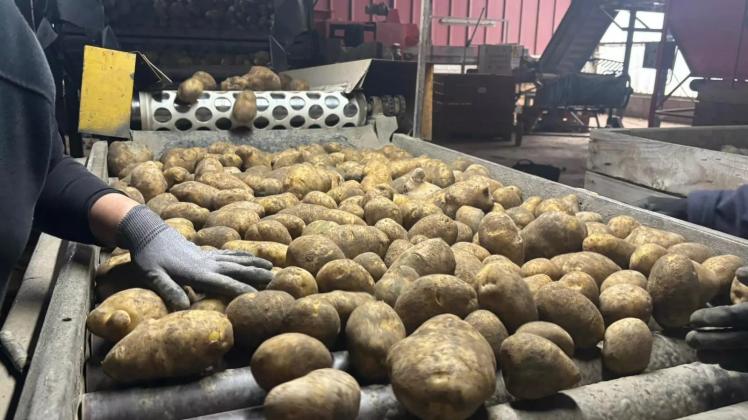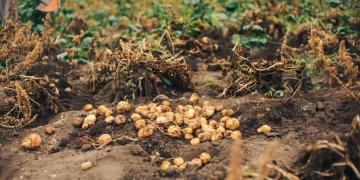Spain (A Limia): Less potato production and low prices
The varieties destined for the potato industry in A Limia have suffered losses of around 30% compared to the typical harvest.

The region ’s star product is nearing the end of this 2025 campaign, which has not been without its climatic setbacks: from heavy rains that delayed planting to extreme heat that scorched the sprouts during their emergence and prolonged the drought until mid-October.
In these last days of October, the pataqueiros (pataqueiros) in Limiao are rushing to harvest the last few hectares of tubers, which contain varieties intended for industry—mostly Agria, but with a presence of varieties such as Rumba and Donata, which are on the rise—which have a longer cycle and pose more problems when it comes to preservation if not properly preserved.
It is in these varieties that farmers have faced the greatest reductions in production, making it difficult to assess average production due to the “grao de heteroxeneidade presente en campo este ano”, according to Inorde, “productions range from exceeding 50,000 kg/ha for varieties such as Donata or Agria, to falling around 20,000 kg/ha”.
This marked difference is the result of the variation in the behavior of the different plots during the germination of the tubers: “In many cases, the potato yielded poor germination capacity due to the delay in planting dates and the need for degrowing processes to ensure that the seeds could withstand the delay,” explains Servando Álvarez, technical director of Inorde. This delay was caused by abundant winter rainfall well into spring.
“This potato seed, in a state far from optimal, once suffered in the field from temperatures that exceeded 40 ºC, burning the newly formed shoots and further delaying the emergence, which in many cases, especially in very sandy soils, did not occur,” said Álvarez. These plots are the ones that suffer the most in their production, either due to the size of the tubers or the quantity.
"In general terms, considering all the above, I would say a reduction in total Limia production of about 30%", they confirm from Inorde, pointing out that if "we consider 120 million kg as representative production of a typical year in Limia, this year we would be around 80 million kg".
Lack of maturity
The dominant trend in these varieties is a lack of ripening, manifested by a lack of suberization of the skin, which can cause problems during storage. “The low relative humidity during harvesting helped prevent major problems,” explains Álvarez, emphasizing that “it should be noted that in the harvests these days, a lack of a well-formed skin can cause bacterial proliferation.”
Toña Calvo Carballo, a farmer from Limiá named Producer of the Year at the 2nd National Potato Awards, explained that Agria’s production has dropped considerably this year. The potatoes they are finishing harvesting these days already have well-formed skins, but they had to "give it time, because it’s dangerous to preserve them before their cycle is complete."
Low prices
The main concern among farmers is the price per kilo of potatoes, which, according to Víctor Cabido, "in terms of sour and industrial prices, we’re talking about between 12 and 15 cents per kilo." Many estimate that these prices don’t even come close to covering current production costs: seeds, chemical fertilizers, phytosanitary products, labor, and gasoline have all risen substantially in price in recent years. "Since the pandemic, everything has gone up a lot," notes Toña Calvo.
Victor explains that “nesta cosecha os gastos foron moi alto” (nesta harvest expenses were very high) and prices have dropped due to competition from foreign tubers—mainly French—and domestic ones.
Kennebec potatoes: the opposite situation
The Kennebec variety, the region’s other star variety, has already been fully harvested, making it the "surprise of the year," according to Servando Álvarez, technical director of Inorde, due to the production that "easily reached 40,000 kg/ha of commercial product." This variety is planted in plots located outside the Lagoa de Antela, since "the black soil in this area is not well suited to the variety because it gives it a non-desirable dark color to the potato skin," explains Álvarez.
Desde la Indicación Xeográfica Protexida Pataca de Galicia (IXP) apuntan que todas las hectáreas de la comarca de A Limia (el 70% de las 400 que tiene como superficie declarada), están ya recogidas, compartiendo con el Inorde el registro medio de kilos por hectárea: “As produccións en irgadío foron bastante boas, en torno os 38.000-40.000 Kg/ha”.
Desde la IXP explican que “as reducións dos rendamentos foron debidos os fallos de nascida que se deron na sementeira”, pero que al tener un ciclo de cultura más corto, lo completó “sen difícilde, polo que Entrar nos almacéns coa pel ben suberizada”. Si bien Álvarez apunta a las idiosincrasias de los productores a título individual como origen de las diferencias en producción dentro de esta varietyad.
"Throughout the crop this year, there were no major phytosanitary problems," they emphasize, expanding that the Limiao product "entered the warehouses in good phytosanitary conditions, and with good organoleptic quality."
Fuente: Traducido por Argenpapa de: The Region




